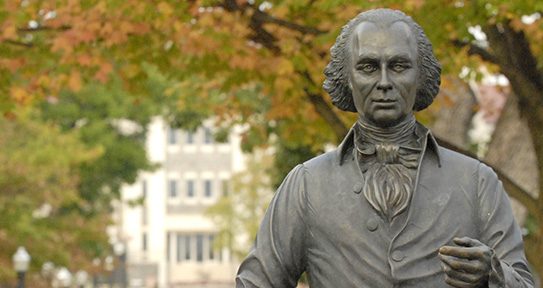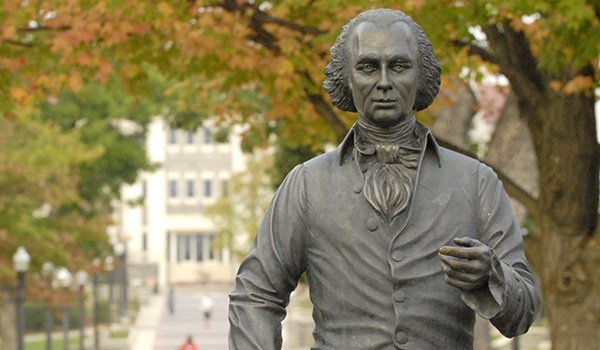The Kind of Book Political Theorists Ought to Read
That drip-drip-drip sound you hear is condescension falling from the mouths of skeptics appalled that such as Lynne Cheney, who does not even hold a tenured position on a university faculty and whose hands are sullied by the actual practice of politics, to say nothing of the side on which she has practiced it, and whose previous writings have not always sounded the depths of profundity, has now dared without so much as the permission of a double-blind peer-review process to produce a sober, scholarly biography of James Madison and, what is worst of all, with a prestigious trade press. Never mind. James Madison: A Life Reconsidered is a serious book, and an excellent one.
There are, of course, reasons to approach it with a skeptical eye. Cheney has proven to be an occasional ideologue in her defense of anti-terrorism policies that stretch the Constitution into un-Madisonian shapes, especially in its executive dimensions. But those looking for offense in these pages will have difficulty finding it. Indeed, those looking for the voice of a neoconservative ideologue will have difficulty finding that, too.
Amid a recent eruption of Madison scholarship, this biography stands out. It may lack the zeal for detail of the classic studies, like Drew McCoy’s The Last of the Fathers (1989),that look at particular periods of Madison’s life. It neither aspires to nor attains the majestic breadth of Irving Brant’s six-volume life. Nor is it a work of political theory. But as a single-volume biography that contextualizes and deepens our understanding of America’s foremost philosopher-practitioner of constitutionalism, it is first-rate.
It is also adulatory to the point of requiring the occasional grain, or even shake, of salt— as in its characterization of Madison and Jefferson as “the two greatest minds of the eighteenth century.” That is savory stuff, as unnecessary as it is unsustainable. But there are worse sins than excess regard for one’s patrimony.
The only place that this verging on the hagiographic seriously impairs Cheney’s analysis is when it leads her to exaggerate the role of abstract reason in the crafting of the Constitution, which did not, to borrow Burke’s sardonic allusion to the self-conception of the revolutionary French, emerge from Madison’s pen “ready made and ready armed, mature in its birth, a perfect goddess of wisdom and war, hammered by our blacksmith midwives out of the brain of Jupiter himself.”
By the time the delegates gathered in Philadelphia in the summer of 1787, American political forms had been evolving indigenously for more than 160 years. The Framers utilized them, adapted them, worked within the constraints imposed by them. John Dickinson famously warned at the Convention that “experience must be our only guide. Reason may mislead us.”
This, by contrast, is Cheney’s portrait of Madison on the eve of Philadelphia:
Madison was the political equivalent of Mozart in the late 1770s. . . . He was Einstein … on the verge of his annus mirabilis, the miracle year of 1905. . . . [H]e was more knowledgeable and better practiced in the theories and realities of representative government than anyone in the country or even the world. And he was about to do what geniuses do: change forever the way people think.
This is a bit much—again, a forgivable patriotism. Madison’s success in changing minds in Philadelphia was strikingly limited. He lost most of the battles in which he engaged. The evidence is reasonably clear that his extended republic thesis (which Cheney, under the apparent sway of the estimable Douglass Adair, calls “a theory on which a great nation could be built”) actually made little impact at the Convention. Indeed, Federalist #10 was not generally recognized as a significant paper until Charles Beard made it the central exhibit in his prosecution of the Founders for aristocratic greed.
The deeper point is that the delegates, while theoretically self-conscious, were above all prudent men, which is to say theory—and rarely abstract, untethered theory at that—played a role but not the sole or even the dominant role in their proceedings. This is well captured when Cheney later quotes Representative Fisher Ames describing Madison as having “derived from nature an excellent understanding. . . . but I think he excels in the quality of judgment.”
Meanwhile Cheney, in her description of the Constitution’s emergence, nearly says outright that there would have been no vast republic had Madison not theorized its possibility. In reality, all events in the Convention were moving in this direction and continued to even after Madison’s debut of his theory, in his speech of June 6, was largely ignored. Madison’s genius, and Hamilton’s—as Cheney notes, both men were skeptical of the Convention’s work—was to use theory to explain what arose largely from prudential judgment. This does not detract from their achievement. It augments it.
The irony of Cheney’s exaggeration of the role of theory at the Convention is that the book as a whole emphasizes events and context, often at theory’s expense. The Federalist receives only a few pages, and not much exegesis. Madison’s explanation for his apparent reversal on the constitutionality of the National Bank, which explains his theory of constitutional change, is reduced to a couple of sentences. Madison’s exchange of letters with Spencer Roane, which is an immensely rich source of understanding of the former’s views of judicial review and majority rule, is only briefly discussed. His 1834 memorandum on majority rule is entirely absent.
These omissions will leave political theorists wanting more. But after all, this is a biography, not an exegetical treatise. It is, indeed, the kind of book political theorists ought to read. There may, for example, be few new insights on the argument of Federalist #10—it is difficult to see how, after a century of exhaustive commentary, there could be—but theorists will benefit from Cheney’s observation that the 1787 breakup of the factious northern coalition supporting the Jay-Gardoqui treaty, which would have traded away navigation rights to the Mississippi, may have helped to stimulate his thinking on it.
Cheney traces the development of Madison’s views on religious freedom with subtlety and insight. She ties his earliest observations on it—in his famous 1774 correspondence with his friend William Bradford—to the nascent theory that would become the Tenth Federalist, observing that he linked “the absence of clashing ideas and competing interests” to corruption. She carefully traces the crucial role he played in establishing religious freedom in Virginia, from his insistence on changing George Mason’s wording in the Virginia constitution (“toleration in the exercise of religion” became the fuller “free exercise of religion”) to his securing passage of Jefferson’s Virginia Statute for Religious Freedom.
Cheney’s observations on Madison’s reading, from Thucydides to Edward Coke to Joseph Priestley and Adam Ferguson, may create new markets for the cottage industry on the sources of Madison’s ideas. One also gets a sense of the important role he played in Virginia’s ratifying convention, and how close a question Virginia’s ratification truly was. The clarity of Madison’s initial opposition to a Bill of Rights emerges, but without either detracting from or embellishing his ultimate zeal for that project, which he introduced with the singularly unenthused descriptor: “neither improper nor altogether useless.”
Many other theoretically substantial episodes in the early Congress, such as the debate over original versus secondary holders of Revolutionary securities, are well told. So are the tragic dimensions of Madison’s complicated and ultimately deteriorating relationship with Washington. His break with Hamilton is carefully, if somewhat one-sidedly, documented.
Despite her overeager description of Madison and Jefferson as the most enlightened minds of an enlightened century, Cheney admirably portrays the complexity of their relationship, in which Madison often tempered Jefferson’s poetic excesses:
Jefferson was the more soaring thinker and would leave behind some of the most uplifting prose ever written. Madison’s genius showed itself in the dismantling of conventional wisdom and the creation of new concepts. Jefferson’s ideas sometimes became untethered from reality, but Madison drew him back to the solid earth—and often found himself inspired by the adventure.
As Cheney shows, notwithstanding Madison’s frequently imposing the law of gravity on Jefferson’s ethereal musings, as in the latter’s “earth belongs to the living” theory that all laws should expire after 19 years, the younger man tenderly cared for his friend’s legacy after his death, including refusing to disclose details of their dealings that might have been salutary for Madison’s own reputation.
Her most original contribution is her case that Madison’s “bilious” episodes were in fact epileptic seizures, though one suspects she at times makes too much of this diagnosis—crediting it, for example, with Madison’s passion for religious freedom on the grounds that he must have been pained by the theory of the age that epilepsy was caused by demonic possession.
Running a close second in originality is her revisionist retelling of the War of 1812, which portrays Madison as, if not a rousing Commander in Chief—for he comes off here as too tolerant too long where his bumbling Secretary of War John Armstrong was concerned—then at least as not himself so bumbling a Commander in Chief as historians have made him out to be. Cheney paints him as ultimately triumphant, and she correctly emphasizes his underappreciated achievement of waging a war while maintaining the republican character of the regime in the face of many anti-republican pressures. He may, indeed, be the only chief executive on record to have fought a war without enlarging his powers.
But it has to be said that Cheney’s answer to the perennial question —for what was this war fought, since the Treaty of Ghent merely confirmed the status quo ante?—does not wholly satisfy. It borders on suggesting that it was an opportunity for Americans to flex muscle and display confidence:
In waging the War of 1812, Americans had almost immediately shown that despite the small size of their navy, they had the potential to be a great sea power. And though it took some time, the United States ultimately demonstrated the strength it could field in a land force.
This has something of the feel of a bait-and-switch, the justifications for the war having been wholly different and surely more persuasive than these new ones would have been.
Perhaps we ought to page the contemporary Lynne Cheney, a vigorous defender of neoconservative military and foreign policy, in this context. Speaking of whom, she somewhat overstates Madison’s commitment to executive power. It is true, as she says, that he was responsible for altering the language of the Constitution’s first article to clarify that Congress had the power to “declare” war, not to “make” it, thus reserving for the President the authority to repel attacks. She also places Madison at the beginning of the Jefferson administration arguing that the President could mount a military campaign without congressional authorization if a foreign power put the nation into a state of war.
Yet she omits a far more salient contrast: Madison’s insistence on going to Congress to declare the War of 1812 despite his belief that Britain was already guilty of casus belli. It is significant, then, that Cheney shortchanges Madison’s Helvidius essays, in which he challenged the unilateral power of the President to determine foreign policy—relegating the essays to less than a paragraph, with no discussion of their content.
Some might say Cheney is exaggerating Madison’s view of presidential power to advance her contemporary view of presidential authority. But it is to Cheney’s credit that this is the only sense in which it could even vaguely be said that politics intrudes on her narrative, and William of Occam would counsel that simpler explanations—namely, reasonable interpretive disagreements—better account for them than the grinding of covert axes. Which is the point: Those who dismiss this admirable book because of its author will deny themselves, at their loss, a richer acquaintance with its subject.



